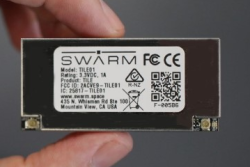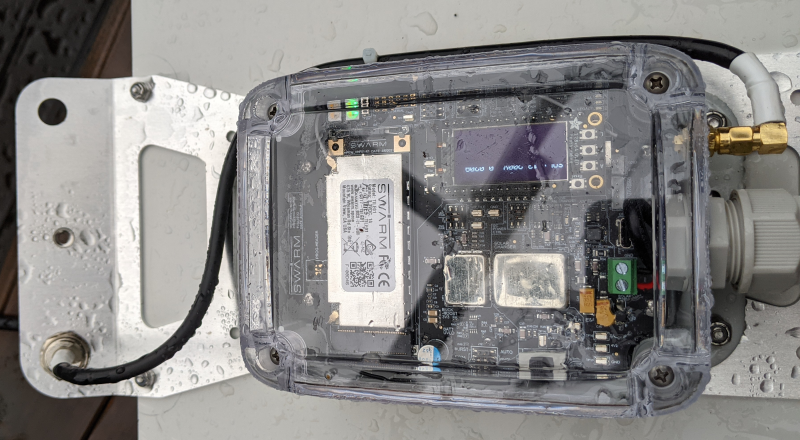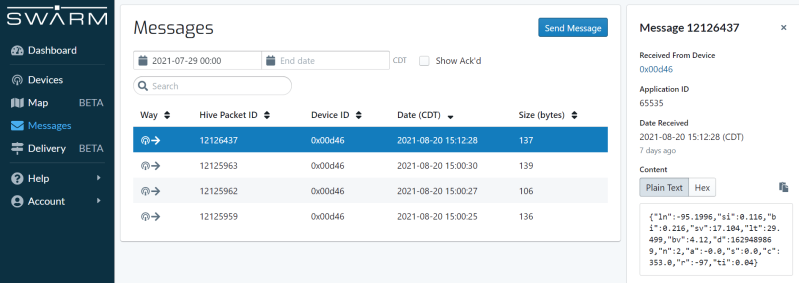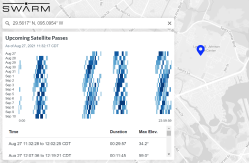If you have devices out in the field, you probably want to connect with them. There was a time when that was hard to do, requiring telephone wires or specialized radio gear. Now cellular data is prevalent, but even cellular isn’t everywhere. If you have the cash, you can pay a number of satellite companies to carry your data, but that’s generally pricey and has its own challenges.
The age of satellite constellations is changing that. Of course everyone by now has heard of Starlink which is offering satellite internet via numerous satellites that are much smaller than traditional telecom satellites. But they’re not the only came in town.
A company called Swarm has put up a constellation of 1/4U cube satellites in low orbits. They offer a ground station that uses an omni antenna and a subscription access program for small amounts of data. They sent us a unit to review, and while I haven’t used the system in a real project yet, the kit was pretty impressive.
About Swarm

The Swarm “tile” is a tiny radio that can talk bi-directionally with small satellites in low Earth orbit. The little unit is made to mount on a PCB, can control its power consumption, and talks to your system via a standard 3.3V UART connection. It does, however, require a small antenna and maybe even a smaller antenna for its GPS module. Small, in this case, is about a mid-size handy talkie antenna. There is a half-wave antenna that doesn’t need a ground plane and a shorter antenna that does need a ground plane.
The system can get away with the small antenna because the satellites are in low Earth orbit. However, that also means you don’t always have a satellite overhead. The company claims they will eventually have more coverage but even then, the tile may hold on to your data until it finds a satellite. So for real-time data, this is probably not your answer.
Since these devices are made to go into the field, battery life is often a concern. According to the manual, the device uses up to 1A when transmitting, and up to 35mA on receive. In standby mode, the power draw drops to .022mA.
The tile itself costs just over $100. Then there’s the service. For $60 a year you get 750 data packets per device per month. Each packet can hold up to 192 bytes per packet. That’s enough for two packets a day for even the longest months. Of course, if you need more data or you need more frequent access, that’s something else. You can stack up to 4 data plans on one device, so $20 per month would get you 3,000 packets per month.
All packets aren’t created equal, either. You can have up to 10 downlink packets per day for a maximum of 60 of the 750 allocated per month. So if you really need two-way, you should think about that carefully. Obviously, this isn’t the right service for, say, a system to control a tank level remotely that needs to trade commands and data in both directions multiple times an hour in real-time. But an alarm system that checks in once per day, sends a packet when it goes off, and accepts an infrequent command changing the arm/disarm times, for example, might be a good fit.
The Competition
The usual way you see connected devices talk over satellite is via a VSAT (very small aperture terminal) with a 2-3 foot dish antenna. These tend to be pricey and they are finicky to set up as well. The upside is the satellites don’t move so once you are set up, that’s it (unless your antenna is moving). You always have access to the satellite. Latency, of course, is significant, too.

However, you can find VSAT almost everywhere. Stores use it to keep their point of sale terminals connected, for example. Many lottery machines use VSAT, too. Electric power utilities and gas pipelines use VSAT to collect data from remote locations.
VSAT doesn’t seem like it is really direct competition to Swarm, however. If you need real network connectivity, you can’t really use Swarm. But if you only need a small amount of infrequent data, Swarm is probably a lot cheaper and easier to deploy than a VSAT terminal. It seems to us that the real competition is cheap cellular modems and, of course, cellular won’t do you any good on your data collection buoy in the middle of the ocean. So Swarm isn’t for everyone, but for certain projects, it is probably well worth a look.
There are a few other companies trying to be the satellite provider of choice for IoT applications. There is OqTec, Orbcomm, Kepler Communications, and Fleet along with doubtless other contenders. StarLink will probably be a player in this space too, but so far its been making a splash in providing internet connections. There are also a lot of traditional names like Hughes, GlobalStar, and Iridium that have some IoT product in the market or, at least, announced. However, Swarm seems pretty hacker-friendly compared to some of the other choices.
The Evaluation Kit

The evaluation kit was surprisingly rugged, arriving in a waterproof (IP68) case with a battery, a solar panel, and an ESP32 host computer. There was also a sturdy tripod. It isn’t cheap at $500, but the quality shows and it didn’t feel like it should cost less. There’s a setup video from the company if you’re looking for more detail on that process.
There’s a rubber-domed switch to turn the thing on and an OLED display shows some initial data. The SNR figure on the display and a red LED told me there was too much noise to successfully communicate with the satellite indoors, but sitting out on the patio, the light turned green. I didn’t mount the tripod and that seemed to be no problem.
The green LED doesn’t mean the device is actually talking to a satellite yet, though. As luck would have it, the pass predictor showed I was almost two hours away from a satellite pass. The company says by 2022 they plan to have all 92 satellites up and that will give them “near constant” coverage. Once I had a satellite overhead, though, it all worked as you would expect.
Software
The evaluation kit has a serial connection for the ESP32, but since it is in a watertight case, it is easier to use the WiFi. We noticed the range on the WiFi was limited, probably to reduce the noise for the satellite receiver.

The box sends its GPS location and some other data periodically and using the network interface you can post a short e-mail although, obviously, that will eventually eat up your data plan. By default, the data shows up on a website, and you can grab the JSON from a web service. You can also see the GPS data on a map which is only interesting if you are moving.

Of course, everything is on hold until you get a satellite overhead. You can enter your location into a website to see when the upcoming passes are for you.
If you are communicating directly with the tile, you’ll find it uses a NMEA-style communication string just like a GPS. Obviously, there are a few unusual commands, but the data format is the same.
What Would You Do With It?
When you first start thinking of what you could do with satellite data, your imagination will run wild. Then you have to come back to Earth — so to speak — when you realize you have to severely limit your data and you can’t expect it to be even close to real-time.
I have a feeling satellite data is one of those things that sounds better than it is for most applications. If you are in range of the cellular network, that might be a cheaper option than you think. However, for those applications that will go where no cell tower has gone before, Swarm might be an answer if you can live within its limitations.
















Even with only 2 connects a day, I think it would be useful for sending data from remote weather stations.
Or water levels, earth tremors. I think of the number of unpopulated islands around the world, some are UN designated as wildlife sanctuaries.
They could even have a “send help” button on them, should someone find themselves stranded in such a location.
Ren,
750 packets per month would be just over 24 per day (24 x 31 = 744), enough for one per hour FROM the remote terminal up to the satellite constellation. That would leave 6 per month in a 31-day month, 30 in a 30-day month, or max out at 60 in February, for replies or commands TO the terminal. So, you could definitely send hourly telemetry and still have a “help me” button on it.
Their website doesn’t mention how they handle overages or adding a second plan (for more upload and download packets) to the device one the fly. But even if you can’t, you could command the terminal to stop sending telemetry packets if the “help me” button if pushed, to save the packets for additional rescue-related traffic.
With a small display like on the eval kit, you would send messages back to the stranded user, like “push button again” (to verify there is a person there) and and “help is on the way” in a few common and local languages. Heck, just deploy the eval kit with, a MCU with a little custom programming, sensors, and an engraved plaque with simple directions in multiple languages, you’d have a pretty straight-forward and durable system for environmental monitoring and the possible SOS call scenario. The hardware and operating cost per unit would still be far less than most similar systems on the market. The one limitation I see for is the number of satellite passes per day, making 2-way emergency communications tough, but Swarm says they’re adding more satellites, which will improve that.
I do think the biggest problem my idea would experience is bird poop on the solar panel.
(Hopefully, there won’t be any trained pigeons expecting food if they peck the button! B^)
I don’t know where I got 750 is 2x per day? I shouldn’t write while I’m fighting a fever, I guess.
You, as I, grew up during the era of “New Math”.
B^)
Or…
maybe the planet you live on has _REALLY_ long months.
B^)
I’m pretty sure you were thinking it was 750 connections per year which works out to a little over 2 per day. You gave the subscription cost $/year so it’s easy to see where you got mixed up.
Interesting tech, it could have a lot of application for remote monitoring, and it’s a lot cheaper than the alternatives I looked at a few years back. I’m generally a bit skeptical about all these nanosat constellations because of pollution concerns as well as the impact on astronomy, but it looks like it does offer some interesting possibilities.
“For $60 a year you get 750 data packets per device per month. […] That’s enough for two packets a day for even the longest months.” If my math is correct, 750 packets per month is a lot more than 2 packets a day, it’s actually enough for a packet every hour. Am i missing something? And 60$ per year is pretty cheap, it’s cheaper than my low-cost cellphone plan.
Actually, looking at your screenshot of satellite passes, it looks like the limiting factor (for now) is actually waiting for a satellite. But with only 192 bytes per packet, even with this limitation, it could be useful to consume multiple packets at a time to send larger amounts of data, such as a batch of recorded monitoring data.
During your tests, what did you think of latency and transmission speed? I mean, if you want to send, let’s say 2kb of data in 12 packets, can you do this during the time window you get from a single satellite pass?
Small nitpick : NMEA, not NEMA.
“I’m generally a bit skeptical about all these nanosat constellations because of pollution concerns as well as the impact on astronomy, but it looks like it does offer some interesting possibilities.”
That ship has already sailed. Now we’re at the mitigation or alternative point.
Well this would make for a much better version of lojack as the existing version is garbage at reporting in. They gloat about getting cars back after 20 years but that just means it was so crappy that nobody knew where it was for 20 years!
Where is the teardown? What chips are they using in the module? They blacked out all the markings in fcc photos.
If you look at the photo of the boards in the case, you can see that an Adafruit Feather Wing OLED ( https://www.adafruit.com/product/4650 ) is used.
It’s basically LORA technology. There was a joint press release by Semtech and Swarm a while back.
Starlink is the only game in town because Starlink acquired Swarm.
@Chuckz said: “Starlink is the only game in town because Starlink acquired Swarm.”
Speculation is: “SpaceX might be preparing to augment Starlink through a new acquisition.”[1] But nothing is sure yet without a blessing from Big Brother: “The SpaceX application asks the federal regulator to approve transferring Swarm’s FCC satellite licenses to the company.”
Ref.-1, “SpaceX Acquires Swarm, a ‘Nano Satellite’ Startup for Low-Cost Connectivity”, The acquisition may mean SpaceX plans on using the Swarm technology to augment Starlink, the company’s satellite internet service. By Michael Kan, August 9, 2021.
https://www.pcmag.com/news/spacex-acquires-swarm-a-nano-satellite-startup-for-low-cost-connectivity
Or maybe Elon is using the Google/Microsoft paradigm of “Embrace and Terminate”.
B^)
More like he sees another revenue stream easily integrated into his existing constellation of satellites. If you’re paying the expense of putting stuff in orbit, it’s smart to offer more than one service to multiple markets.
At the moment I have one of the Eval Kits and the tile that is being built in to the final product. I have replaced the feather with one of the low power Heltec Wireless Shells and honestly the system runs really well.
The new unit I am working on will be replacing a system I built that was based around the Iridium RockBLOCK.
Swarm is cheaper to send and receive packets, you get larger packets and getting the data in and out is much easier.
The modems seem to comsume a lot less power and the command structure is much easier to use than the RockBLOCK.
The unit I have here has been running for about a month. The technical support over at Swarm is far better than any support I have ever experanced!
May I ask, “Where is your location?”
(in regard to approximate Latitude and Longitude)
Thanks!
Hi Ren,
The new Swarm unit I am working on is about “36.915° S, 174.889° E” at the moment, Its actually inside the house looking out a window facing South East and its still doing about 30 messages in a 24hr period. ON the other side of the house outdoors there is a HUGE tree that may be causing some issues as it seems to half the transmissions on that side.
The system this will eventually replace and the one that has the RockBLOCK on it and that has sadly failed is at the top of Mt Erebus in Antartica. The big issue with this one was there are about 120 sensors each set to 12bit resolution and shoving that over the Iridium network was expensive not to mention chopping the data up in to 51byte packets was a total pain.
A really cool feature in the Swarm network is also the ability to tag a packet with an APID and hand that data directly to a specific process. You can do the same in reverse and tag a message being sent to the Swarm Tile/Modem with its own APID then have the data handled by a specific function.
I have not confirmed but it looks like the APID is also not part of your 192 and even better it looks like if you pack up your sensors in the HEX you can send 384 bytes.
“The system this will eventually replace and the one[…] that has sadly failed is at the top of Mt Erebus in Antarctica.”
“That’s what I talkin’ ’bout!”
-Gru in Despicable Me
This could be a game changer in Global Remote Sensing!
It is amazing that the SpaceBEE satellites are mostly sandwich-sized (0.25U cubesat), they measure 110 x 110 x 28mm (4.3″ x 4.3″ x 1.1″). I’m guessing that the limiting factor to their message handling must be size of their solar panel.
The swarm 0.25U cubesat’s at an orbital altitude from 520 km (320 mi) to 535 km (332 mi) so their flight velocity would be:
7.6015633194063 km/s (orbital period 01:35:01.76 hh:mm:ss)
7.5933119771462 km/s (orbital period 01:35:20.37 hh:mm:ss)
The 0.25U cubesat’s are 400 grams each so their kinetic energy would be between 11556753 J to 11531677 J so about the energy released by the explosion of ~3 kilogram of TNT*. And their orbit will eventually decay enough to intercept the ISS.
(ref: https://en.wikipedia.org/wiki/Orders_of_magnitude_(energy) )
There you have it, a follow-up to the recent HaD article about the future demise of ISS.
B^)
The ISS does have engines so it can dodge all 120 of them!
And at only $5/month it comes with an entire 140,000 bytes of data on its’ data plan. I mean, who would ever need more than 140KB?
I know, I know, it’s geared toward sensor IoT. I’m just making a joke.
At $60/year and $500 for the base station, it is something a cheapskate like me would consider.
Now, to think of a plausible (exc)use to convince my wife…
“The box sends its GPS location and some other data periodically”
Okay, another idea, free floating buoys to map ocean currents/temps.
“Don’t worry about the expense, the government will pay for it!” B^)
You mean like these? https://www.aoml.noaa.gov/global-drifter-program/
This service is a direct competitor to Iridium SBD. Iridium SBD is purely byte based traffic and not a packet/byte combination, which in my mind is restricting. I use Iridium SBD now for remote sensor monitoring and control, and some messages are only 50 bytes, but that would use up a packet. Anyways, its good to see other options out there
Has any company made off-the-shelf units unitizing these for collecting. Just a few discrete inputs and a few 4-20mA inputs?